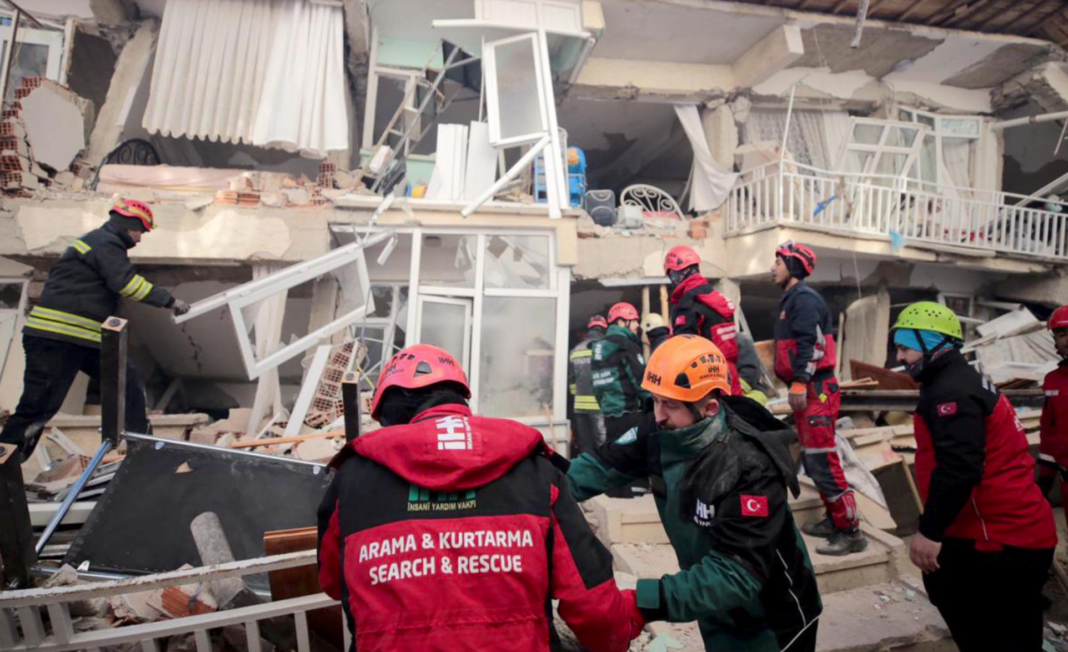The response to the February 6 earthquakes in Turkey and Syria is still focused on immediate disaster response—but much has already been learned, and illuminated, through this tragedy that has killed tens of thousands and flattened towns and cities.
In the quakes’ aftermath, Bloomberg School faculty and students shared their insights, including firsthand accounts of the disaster, during a special discussion hosted by the Johns Hopkins Center for Humanitarian Health and in an episode of Public Health On Call.
Their perspectives help us understand gaps in the global response to catastrophes—and how they can be addressed to better respond to future disasters.
This natural disaster has been exacerbated by existing humanitarian and political crises.
Due to the ongoing civil war in Syria, a major hub for humanitarian aid already existed in Gaziantep, Turkey. Unfortunately, this was one of the locations hardest hit by the earthquakes, meaning responders in that area had to first be rescued and relocated before they could mobilize and aid others.
This also meant that when the quakes hit, densely populated areas of northwest Syria—which rely heavily on resources from Turkey—were left largely without assistance, Gilbert Burnham, MD, PhD, MSc, professor emeritus in the Department of International Health, explained.
“There was only one official crossing point, which was seriously damaged by the quake, causing a major delay in assistance,” said Burnham. “Heavy machinery was badly needed, but those resources were already occupied in Turkey,” limiting search-and-rescue efforts.
Survivors need ongoing help as they face a host of health challenges.
Millions in northwest Syria were already displaced before the earthquake—some for the 10th or more time since the war began—and health systems are in tatters from dwindling aid and years of violent attacks on hospitals and other critical infrastructure. Amid freezing temperatures and an ongoing cholera outbreak, the focus now shifts to sheltering and caring for those who have survived.
Paul Spiegel, MD, MPH ’96, director of the Johns Hopkins Center for Humanitarian Health and an expert in preventing and responding to complex humanitarian emergencies, was deployed last year as the emergency coordinator for the WHO’s Ukraine refugee response. He explained that the time after the initial search-and-rescue period is critical for protecting the lives spared. “You likely will save a lot more people by ensuring you have surveillance and thinking about continuing care and supplies,” Spiegel told the Washington Post.
Building codes can save lives—but only if they are enforced.
In Turkey, catastrophes like the 1999 earthquake in Izmit, which killed 17,000 people, ushered in strict building standards. The problem: “Nobody enforced them”—and construction amnesties have allowed builders to “buy off” accountability for subpar construction, Burnham noted. These holes in enforcement left many buildings vulnerable in the face of the quake.
Building codes are “one of the most powerful things we can do to protect populations”—but a lack of enforcement can cost lives, said Burnham.
Local first responders must be protected and empowered.
Among the survivors of the February 3 earthquakes is Bara Zuhaili, a Syrian-born vascular surgeon and Bloomberg School MPH candidate. Zuhaili highlighted the immediate response efforts in northwest Syria, despite slow-to-arrive international aid, as proof that enabling local response to humanitarian crises has been effective.
One of those working to support localized efforts is Amany Qaddour, MHSA, an International Health DrPH candidate and executive director of Syria Relief & Development (SRD), a nonprofit dedicated to deploying aid in Syria. Qaddour, who lives part-time in Gaziantep, shared her priority of ensuring that her staff is taken care of with adequate shelter, pay, and mental health support. “If we don’t take care of them, they can’t take care of others,” she said.
It’s worth rethinking how aid money moves.
Ongoing financial support is essential for organizations on the ground—like the White Helmets and SRD—that have already been and will continue to be active in recovery efforts. Qaddour emphasizes that in times of crisis, international partnerships are imperative, but it’s local organizations that have the most meaningful impact, due to their deeper understanding of cultural context and nuance.
Often, however, the bulk of emergency response funding is funneled through the UN and international NGOs—not the most efficient way to deploy funding quickly, noted Spiegel. Given that much of that funding eventually ends up with local on-the-ground organizations, Qaddour added that “sometimes you do need to cut out the middleman” to expedite support.
The response to this disaster should inform our response to the next one.
However shocking this tragedy, the vulnerabilities it lays bare are a common reality in many other parts of the world. “When you look at vulnerability and displacement, and violent conflict, and climate crises, and natural disasters, compounding on some of the most vulnerable people … we need to change the blueprint for how we respond,” Qaddour said.
While the immediate search-and-rescue period is over, the response to this compounded crisis will continue for months and years to come. In terms of both effective and ineffective strategies, and both local and global responses, “we need to be documenting what we’re doing now, finding out how we can apply this to other inevitable crises,” said Qaddour.
For individuals looking to help—know what not to do.
“Please do not go there; you will only be detrimental to the response,” said Qaddour. Unless you are a trained responder with a large international organization, “you should not be parachuting in.”
Additionally, she said, “Try to minimize sending [supplies]. We do not want to dismantle the local economies” with massive donation drives of items that might not be contextually or culturally appropriate.
It’s more helpful to support organizations already on the ground in the region, like the White Helmets and Syria Relief and Development.
Annalies Winny is associate editor of Global Health NOW, a website and daily e-newsletter produced by the Bloomberg School.
Aliza Rosen is a digital content strategist at the Johns Hopkins Bloomberg School of Public Health.

